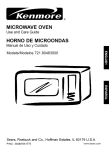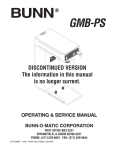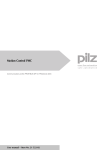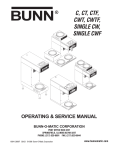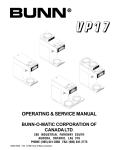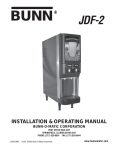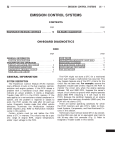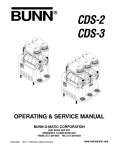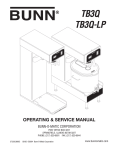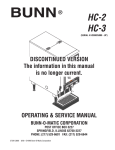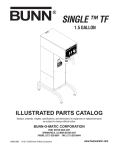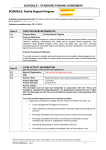Download Service Manual - Guertech Inc.
Transcript
BUNN ® S,SA ST,STA STF,STFA OPERATING & SERVICE MANUAL BUNN-O-MATIC CORPORATION POST OFFICE BOX 3227 SPRINGFIELD, ILLINOIS 62708-3227 PHONE: (217) 529-6601 FAX: (217) 529-6644 29251.0000G 04/01 ©1998 Bunn-O-Matic Corporation www.bunnomatic.com WARRANTY Bunn-O-Matic Corp. (“Bunn”) warrants the equipment manufactured by it to be commercially free from defects in material and workmanship existing at the time of manufacture and appearing within one year from the date of installation. In addition: 1.) Bunn warrants electronic circuit and/or control boards to be commercially free from defects in material and workmanship for three years from the date of installation. 2.) Bunn warrants the compressor on refrigeration equipment to be commercially free from defects in material and workmanship for two years from the date of installation. 3.) Bunn warrants that the grinding burrs on coffee grinding equipment will grind coffee to meet original factory screen sieve analysis for three years from date of installation or for 30,000 pounds of coffee, whichever comes first. This warranty does not apply to any equipment, component or part that was not manufactured by Bunn or that, in Bunn’s judgement, has been affected by misuse, neglect, alteration, improper installation or operation, improper maintenance or repair, damage or casualty. THE FOREGOING WARRANTY IS EXCLUSIVE AND IS IN LIEU OF ANY OTHER WARRANTY, WRITTEN OR ORAL, EXPRESS OR IMPLIED, INCLUDING, BUT NOT LIMITED TO, ANY IMPLIED WARRANTY OF EITHER MERCHANTABILITY OR FITNESS FOR A PARTICULAR PURPOSE. The agents, dealers or employees of Bunn are not authorized to make modifications to this warranty or to make additional warranties that are binding on Bunn. Accordingly, statements by such individuals, whether oral or written, do not constitute warranties and should not be relied upon. The Buyer shall give Bunn prompt notice of any claim to be made under this warranty by telephone at (217) 529-6601 or by writing to Post Office Box 3227, Springfield, Illinois, 62708-3227. If requested by Bunn, the Buyer shall ship the defective equipment prepaid to an authorized Bunn service location. If Bunn determines, in its sole discretion, that the equipment does not conform to the warranty, Bunn shall repair the equipment with no charge for parts during the warranty period and no charge for labor by a Bunn Authorized Service Representative during the warranty period. If Bunn determines that repair is not feasible, Bunn shall, at its sole option, replace the equipment or refund the purchase price for the equipment. THE BUYER’S REMEDY AGAINST BUNN FOR THE BREACH OF ANY OBLIGATION ARISING OUT OF THE SALE OF THIS EQUIPMENT, WHETHER DERIVED FROM WARRANTY OR OTHERWISE, SHALL BE LIMITED, AS SPECIFIED HEREIN, TO REPAIR OR, AT BUNN’S SOLE OPTION, REPLACEMENT OR REFUND. In no event shall Bunn be liable for any other damage or loss, including, but not limited to, lost profits, lost sales, loss of use of equipment, claims of Buyer’s customers, cost of capital, cost of down time, cost of substitute equipment, facilities or services, or any other special, incidental or consequential damages. #00831.0000 USER NOTICES Page 2 #00658.0000 29251 042301 USER NOTICES (Continued) #00882.0000 #00656.0000 #02763.0000 #02765.0000 #02769.0000 Page 3 29251 101598 ELECTRICAL REQUIREMENTS CAUTION - The brewer must be disconnected from the power source until specified in Initial Set-Up. Model 15 has an attached cordset and requires 2-wire grounded service rated 120 volts ac, 15 amp, single phase, 60 Hz. L2 RED WHITE NEUTRAL L1 BLACK WHITE 120V.A.C. NEUTRAL WHITE 120V A.C. 208 or 240V.A.C. 120V A.C. NEUTRAL L1 BLACK 100V.A.C. L1 BLACK P2185 Model 20 requires 2wire, grounded service rated 120 volts ac, 20 amp, single phase, 60 Hz. Proceed as follows: P1841 Model 35 requires 3wire, grounded service rated 120/208 or 120/240 volts ac, 20 amp, single phase, 60 Hz. Proceed as follows: P2185 P2193 “A" & "B” models require 2-wire, grounded service rated 200 volts ac or 240 volts ac, 20 amp, single phase, 50 Hz. Proceed as follows: "SDB” model requires 2-wire, grounded service rated 100 volts ac, 20 amp, single phase, 50 Hz. Proceed as follows: Electrical Hook-Up CAUTION – Improper electrical installation will damage electronic components. 1. An electrician must provide electrical service as specified. 2. Using a voltmeter, check the voltage and color coding of each conductor at the electrical source. 3. Before electrically connecting the brewer, remove the front and rear panel and rotate the thermostat knob fully counterclockwise to the "OFF" position. Keep this knob in the "OFF" position until performing the "Initial Set-Up" 4. Feed the power cord through the strain relief and connect it to the terminal block. 5. Connect the brewer to the power source and verify the voltage at the terminal block before proceeding. (Models S and ST-15 have cord attached. Replace all panels. 6. If plumbing is to be hooked-up later be sure the brewer is disconnected from the power source. If plumbing has been hooked-up, the brewer is ready for "Initial Set-Up". NOTE: Schematic wiring diagrams are included in this manual. PLUMBING REQUIREMENTS Models S & SA: These models are completely portable and require no attached plumbing. Models ST, STA, STF & STFA These brewers must be connected to a cold water system with operating pressure between 20 and 90 psi (138 and 620 kPa) from a 1⁄2" or larger supply line. A shut-off valve should be installed in the line before the brewer. Install a regulator in the line when pressure is greater than 90 psi (620 kPa) to reduce it to 50 psi (345 kPa). The water inlet fitting is 1⁄4" flare. NOTE - Bunn-O-Matic recommends 1⁄4" copper tubing for installations of less than 25 feet and 3⁄8" for more than 25 feet from the 1⁄2" water supply line. A tight coil of copper tubing in the water line will facilitate moving the brewer to clean the countertop. Bunn-O-Matic does not recommend the use of a saddle valve to install the brewer. The size and shape of the hole made in the supply line by this type of device may restrict water flow. This equipment must be installed to comply with the Basic Plumbing Code of the Building Officials and Code Administrators International, Inc. (BOCA) and the Food Service Sanitation Manual of the Food and Drug Administration (FDA). Page 4 29251 011800 INITIAL SET-UP CAUTION - The brewer must be disconnected from the power source throughout the initial set-up, except when specified in the instructions. 1. 2. 3. Insert an empty funnel into the funnel rails. Place an empty dispenser under the funnel. Remove the front or rear panel and turn the thermostat knob to the “OFF” position and connect the brewer to the power source. 4. Fill the tank with water as directed: 4A. Models S & SA: Pour three pitchers of tap water into the screened area on top of the brewer. Allow approximately two minutes between pitchers for water to flow into the tank. While the third pitcher of water is entering the tank, the tank will fill to capacity and the excess will flow from the sprayhead, out of the funnel, and into the dispenser. 4B. Models ST, STA: Connect the brewer to the power source, place the "ON/OFF" switch in the "ON" upper position, and momentarily press and release the start switch. Water will begin flowing into the tank. When water stops flowing into the tank, initiate a second and a third brew cycle. During the third brew cycle the tank will fill to its capacity and the excess will flow from the sprayhead, out of the funnel, and into the dispenser. 4C. Models STF & STFA Brewers will fill automatically when lower ON/OFF switch is placed in the "ON" position and tank will fill to capacity. 5. When the flow of water from the funnel stops, turn the thermostat knob to the “ON” position and wait approximately twenty minutes for the water in the tank to heat to the proper temperature. Some water will drip from the funnel during this time; this is due to expansion and should not occur thereafter. 6. Empty the dispenser and initiate another brew cycle as directed: 6A. Models S & SA: Pour one pitcher of tap water into the screened area on top of the brewer. 6B. Models ST, STF, STA & STFA: Place the "ON/OFF" switch in the "ON" upper position, and momentarily press and release the start switch. 7. Place the "ON/OFF" switch in the lower “OFF” position after water has stopped flowing from the funnel, and let the water in the tank reheat to the proper temperature. 8. Empty the dispenser and proceed as directed: 8A. Models S & SA: The brewer is now ready for use in accordance with the coffee brewing instructions on the next page. 8B. Models ST, STF, STA & STFA: Place the "ON/OFF" switch in the "ON" upper position, and momentarily press and release the start switch. Check the water volume in the dispenser after water has stopped flowing from the funnel. It should be 64 ounces. 9. If not, disconnect the brewer from the power source. On early models remove the access panel. Adjust the timer as required (see service section). Replace the panel, connect the brewer to the power source, and allow the water to reheat, start, and measure another brew cycle. 10. Repeat step 9 until 64 oz water volume is achieved. 11. The brewer is now ready for use in accordance with the coffee brewing instructions on the next page. Page 5 29251 052500 OPERATING CONTROLS Models S & SA: These models function without operating controls. Models ST, STF, STA & STFA: ON/OFF SWITCH Placing the "ON/OFF" switch in the "OFF" lower position stops brewing. Stopping a brew cycle after it has been started will not stop the flow of water into the funnel until the tank syphons down to its proper level. Placing the switch in the "ON" upper position supplies power to the brew station warmer and enables the brew circuit and on Models STF and STFA refills the tank. START SWITCH Momentarily pressing and releasing the switch starts a brew cycle when the "ON/OFF" switch is in the "ON" upper position. NOTE – The "ON/OFF" switch must be in the "ON" upper position to initiate and complete a brew cycle. COFFEE BREWING 1. 2. 3. 4. 5. ® Insert a BUNN filter into the funnel. Pour the fresh coffee into the filter and level the bed of grounds by gently shaking. Slide the funnel into the funnel rails. Place an empty dispenser beneath the funnel. Operate the brewer as directed: 5A. Models S & SA: Pour one pitcher of tap water into the screened area on top of the brewer. 5B. Models ST, STF, STA & STFA: Place the "ON/OFF" switch in the "ON" upper position. Momentarily press and release the start switch. 6. When brewing is completed, simply discard the grounds and filter. CLEANING 1. 2. 3. The use of a damp cloth rinsed in any mild, non-abrasive, liquid detergent is recommended for cleaning all surfaces on Bunn-O-Matic equipment. Check and clean the sprayhead. The sprayhead holes must always remain open. With the sprayhead removed, insert the deliming spring (provided) all the way into the sprayhead tube. When inserted properly, no more than two inches of spring should be visible. Saw back and forth five or six times. NOTE – In hard water areas, this may need to be done daily. It will help prevent liming problems in the brewer and takes less than a minute. Page 6 29251 101598 TROUBLESHOOTING A troubleshooting guide is provided to suggest probable causes and remedies for the most likely problems encountered. If the problem remains after exhausting the troubleshooting steps, contact the Bunn-O-Matic Technical Service Department. • • • • • • • Inspection, testing, and repair of electrical equipment should be performed only by qualified service personnel. All electronic components have 120 volt ac and low voltage dc potential on their terminals. Shorting of terminals or the application of external voltages may result in board failure. Intermittent operation of electronic circuit boards is unlikely. Board failure will normally be permanent. If an intermittent condition is encountered, the cause will likely be a switch contact or a loose connection at a terminal or crimp. Solenoid removal requires interrupting the water supply to the valve. Damage may result if solenoids are energized for more than ten minutes without a supply of water. The use of two wrenches is recommended whenever plumbing fittings are tightened or loosened. This will help to avoid twists and kinks in the tubing. Make certain that all plumbing connections are sealed and electrical connections tight and isolated. This brewer is heated at all times. Keep away from combustibles. WARNING – • • • • Exercise extreme caution when servicing electrical equipment. Unplug the brewer when servicing, except when electrical tests are specified. Follow recommended service procedures Replace all protective shields or safety notices PROBLEM PROBABLE CAUSE REMEDY Brew cycle will not start (ST, STF, STA & STFA) 1. No water Water lines and valves to the brewer must be open. 2. No power or incorrect voltage to the brewer (A1) Check the terminal block for 120 volts across the black and white terminals on two wire 120 volt brewers. (A2) Check the terminal block for 120 volts across the red and white terminals and the black and white terminal on three wire 120/240 volt brewers. (A3) Check the terminal block for 200 volts on Model STFB brewers or 240 volts on "A Series" brewers across the red and black terminals. (A4) Check the terminal block for 100 volts on Model SDB brewers across the white and black terminals. (B) Check circuit breakers or fuses. Page 7 29251 101598 TROUBLESHOOTING (cont.) PROBLEM PROBABLE CAUSE REMEDY Brew cycle will not start (cont.) (ST, STF, STA & STFA) 3. ON/OFF switch Refer to Service - ON/OFF Switch for testing. See page 17 4. Start switch Refer to Service - Start Switch for testing procedures. See page 19 5. Timer Refer to Service - Timer for testing procedures. See page 22 or 24 6. Solenoid valve Refer to Service - Solenoid Valve for testing procedures. See page 18 7. Strainer/flow control GPM) (.222 (A) Direction of flow arrow must be pointing towards brewer. (B) Remove the strainer/flow control and check for obstructions. Clear or replace. Water is not hot Inconsistent beverage level in dispenser 1. Limit thermostat CAUTION - Do not eliminate or bypass limit thermostat. Use only BOM replacement part #29329. 1000. Refer to Service - Limit Thermostat for testing procedures. See page 16 2. Control thermostat Refer to Service - Control Thermostat for testing procedures. See page 14 3. Tank heater Refer to Service - Tank Heater for testing procedures. See page 20 1. Strainer /flow control (.222 GPM) (ST, STF, STA & STFA) (A) Direction of flow arrow must be pointing towards the brewer. (B) Remove the strainer/flow control and check for obstruction. Clear or replace. 2. Liquid level board or level probe Page 8 Refer to Service - Liquid Level Board for testing procedures. See page 26 29251 052500 TROUBLESHOOTING (cont.) PROBLEM PROBABLE CAUSE REMEDY Inconsistent beverage level in dispenser (cont.) 3. Syphon system The brewer must be level or slightly lower in front to syphon properly. 4. Lime build-up CAUTION - Tank and tank components should be delimed regularly depending on local water conditions. Excessive mineral build-up on stainless steel surfaces can initiate corrosive reactions resulting in serious leaks. Inspect the tank assembly for excessive lime deposits. Delime as required. 5. Water pressure (ST, STF, STA & STFA) The water pressure to the brewer must be at least 20 psi (138 kPa). 1. Timer (A) Early models-Timer dial must indicate at least two minutes and fifteen seconds. Consistently low beverage level in the dispenser (ST, STF, STA & STFA) (B) Refer to Service - Digital Timer for testing procedures. See page 24 2. Strainer/flow control (.222 GPM) (A) Direction of flow arrow must be pointing towards brewer. (B) Remove the strainer/flow control and check for obstructions. Clear or replace. Spitting or excessive steaming 1. Lime build-up CAUTION - Tank and tank components should be delimed regularly depending on local water conditions. Excessive mineral build-up on stainless steel surfaces can initiate corrosive reactions resulting in serious leaks. Inspect tank assembly for excessive lime deposits. Delime as required. 2. Control thermostat Refer to Service - Control Thermostat for testing procedures. See page 14 Page 9 29251 052500 TROUBLESHOOTING (cont.) PROBLEM PROBABLE CAUSE REMEDY Dripping from sprayhead 1. Syphon system The brewer must be level or slightly lower in front to syphon properly. 2. Lime build-up CAUTION - Tank and tank components should be delimed regularly depending on local water conditions. Excessive mineral build-up on stainless steel surfaces can initiate corrosive reactions resulting in serious leaks. Inspect the tank assembly for excessive lime deposits. Delime as required. 3. Solenoid valve (ST, STF, STA & STFA) Remove the solenoid valve and clear any obstructions. Rebuild or replace the valve if necessary. See page 18 1. Timer (ST, STF, STA & STFA) Refer to Service - Timer for testing procedures. See page 22 or 24 2. Start switch Refer to Service - Start Switch for testing procedures. See page 19 3. Liquid level board Refer to Service - LiquidLevel Board for testing procedures. See page 26 4. Relay Refer to Service - Relay for testing procedures. See page 28 Water flows into tank continuously (ON/OFF Switch "OFF") 1. Solenoid valve (ST, STF, STA & STFA) Remove the Solenoid Valve and clean any obstruction. Rebuild or replace the valve if necessary. See page 18 Beverage overflows dispenser 1. Dispenser The dispenser must be completely empty before starting a brew cycle. 2. Timer (ST, STF, STA & STFA) Refer to Service - Timer for testing procedures. See page 22 or 24 Water flows into tank continuously (ON/OFF Switch "ON") Page 10 29251 052500 TROUBLESHOOTING (cont.) PROBLEM PROBABLE CAUSE REMEDY Beverage overflows dispenser (cont.) 3. Solenoid valve (ST, STF, STA & STFA) Remove the Solenoid Valve and clean any obstruction. Rebuild or replace the valve if necessary. See page 18 Weak beverage 1. Filter type The BUNN® paper filter must be used for proper extraction. 2. Coffee grind A fine or drip grind must be used for proper extraction. 3. Sprayhead A six-hole stainless steel sprayhead must be used for proper extraction. 4. Funnel loading The BUNN® paper filter must be centered in the funnel and the bed of ground leveled by gentle shaking. 5. Water temperature Place an empty funnel on an empty dispenser beneath the sprayhead. Initiate a brew cycle and check the water temperature immediately below the sprayhead with a thermometer. The reading should not be less than 195°F. Adjust the control thermostat to increase the water temperature. Replace if necessary. Dry coffee grounds remain in the funnel 1. Funnel loading The BUNN® paper filter must be centered in the funnel and the bed of grounds leveled by gently shaking. Brewer is making unusal noises (ST, STF, STA & STFA) 1. Solenoid valve The nut on the solenoid must be tight or it will vibrate during operation. 2. Plumbing lines Plumbing lines should not resting on the counter top. Page 11 29251 052500 TROUBLESHOOTING (cont.) PROBLEM PROBABLE CAUSE REMEDY Brewer is making unusal noises (ST, STF, STA & STFA)(cont.) 3. Water supply (A) The brewer must be connected to a cold water line. (B) Water pressure to the brewer must not exceed 90 psi (620 kPa). Install a regulator if necessary to lower the working pressure to approximately 50 psi (345 kPa). Automatic refill will not operate 4. Tank heater Remove and clean lime off the tank heater. See page 20 1. No water Check plumbing 2. Strainer/flow control A. Direction of arrow must be pointing towards brewer. B. Remove the strainer/flow control and check for obstructions. Clean or replace. Beverage not staying hot in dispenser 3. Solenoid valve Refer to Service - Solenoid Valve for testing procedures. See page 18 4. Liquid level control board or level probe Refer to Service - Liquid level control board or level probe for testing procedures. See page 26 5. Relay Refer to Service - Relay for testing procedures. See page 28 1. ON/OFF switch Refer to Service - ON/OFF switch for testing procedures. See page 17 2. Warmer elements Refer to Service - Warmer elements for testing procedures. See page 29 Page 12 29251 052500 SERVICE This section provides procedures for testing and replacing various major components used in this brewer should service become necessary. Refer to Troubleshooting for assistance in determining the cause of any problem. WARNING - Inspection, testing, and repair of electrical equipment should be performed only by qualified service personnel. The brewer should be unplugged when servicing, except when electrical tests are required and the test procedure specifically states to plug-in the brewer. COMPONENT ACCESS WARNING - Disconnect the brewer from the power source before the removal of any panel or the replacement of any component. All components are accessible by the removal of the top cover or top warmer housing and front and rear inspection panels. The top cover for Models with no top warmer and the top warmer housing is attached with four #8-32 screws. Unplug upper wiring harness and set housing aside. The front and rear inspection panels are attached with four #8-32 screws each. Contents Control Thermostat ............................................. 14 Limit Thermostat ................................................ 16 ON/OFF Switch.................................................... 17 Solenoid ............................................................. 18 Start Switch (Brew) ............................................ 19 Tank Heater ........................................................ 20 Brew Timer (Early Models) ................................. 22 Digital Timer (Late Models) ................................ 24 Liquid Level Board ............................................. 26 Relay.................................................................. 28 Warmer Element ................................................ 29 Thermal Cut-off ................................................. 30 Wiring Diagrams .................................... 31 thru 43 Page 13 P1584 FIG. 1 COMPONENT ACCESS 29251 052500 SERVICE (cont.) CONTROL THERMOSTAT BU OFF Test Procedures: 1. Disconnect the brewer from the power source. 2. Locate the blue wire on the control thermostat. 3. Check the voltage across the blue wire on the control thermostat and the white insert on two pole 100 or 120 volt terminal block or three pole 120/240 volt terminal blocks and the red insert on two wire 200 volt or 240 volt terminal block with a voltmeter. Connect the brewer to the power source. The indication must be: a) 120 volts ac for two wire 120 volt models and three wire 120/240 volt models. b) 200 to 240 volts ac for two wire 200 or 240 volt models. c) 100 volts ac for two wire 100 volt models. 4. Disconnect the brewer from the power source. NN HI If voltage is present as described, proceed to #5. If voltage is not present as described, refer to the Wiring Diagrams and check the brewer wiring harness. 5. 6. 7. 8. P1585 FIG. 2 CONTROL THERMOSTAT Locate the black wire on the control thermostat. Gently remove the capillary bulb and grommet from the tank. Check the voltage across the black wire of the control thermostat and the white insert on the two pole 100 or 120 volt or three pole 120/240 volt terminal block and the red insert on the two pole 200 volt or 240 volt terminal block with a voltmeter when the control thermostat is turned "ON" (Fully clockwise). Connect the brewer to the power source. The indication must be: a) 120 volts ac for two wire 120 volt models and three wire 120/240 volt models. b) 200 to 240 volts ac for two wire 200 volt or 240 volt models. c) 100 volts ac for two wire 100 volt models. Disconnect the brewer from the power source. If voltage is present as described, reinstall the capillary tube into the tank to the line 4.5" above the bulb, the control thermostat is operating properly. If voltage is not present as described, replace the thermostat. Location: Models S & SA: The control thermostat is mounted on a bracket inside the rear inspection cover on the left side. Models ST, STA, STF & STFA: The control thermostat is located inside the front inspection cover on the component mounting bracket. Page 14 29251 052500 SERVICE (cont.) NOTE - The capillary tube must be clear of any electrical termination and not kinked. 7. 8. 9. Models S & SA: Using two #8-32 screws secure the control thermostat inside the rear inspection panel. Models ST, STA, STF & STFA: Using one #8-32 screw secure the control thermostat to the component bracket inside the front inspection panel. Refer to FIG. 3 when reconnecting the wires. Adjust the control thermostat as required. BLU to Limit Thermostat BLK to Tank Heater NN BU OFF Removal and Replacement: 1. Remove wires from control thermostat leads. 2. Remove the thermostat capillary bulb by firmly pulling-up on the capillary at the tank lid. This will disengage the grommet from the tank lid. 3. Models S & SA: Remove the two #8-32 screws securing control thermostat bracket mounted inside the rear inspection panel. Models ST, STA, STF & STFA: Remove the one #8-32 screw securing the control thermostat to the component bracket in the front inspection panel. 4. Slide the grommet to the line 4.5" above the bulb on the new capillary tube. 5. Insert the capillary bulb through the hole in the tank lid and press the grommet firmly and evenly so that the groove in the grommet fits into the tank lid. 6. Carefully bend the capillary tube so that the tube and bulb inside the tank are in the vertical position. HI CONTROL THERMOSTAT (cont.) P2182 FIG. 3 CONTROL THERMOSTAT TERMINALS Page 15 29251 052500 SERVICE (cont.) LIMIT THERMOSTAT Removal and Replacement: 1. Remove all wires from limit thermostat terminals. 2. Carefully slide the limit thermostat out from under the retaining clip and remove limit thermostat. 3. Carefully slide the new limit thermostat into the retaining clip. 4. Refer to FIG. 5 when reconnecting the wires. BLK to Tank Heater Switch P1586 BLK to BLU Lead from Control Thermostat FIG. 4 LIMIT THERMOSTAT Location: The limit thermostat is located on the rear of tank assembly. Test Procedures: 1. Disconnect the brewer from the power source. 2. Disconnect the blue and black wires from the limit thermostat. 3. Check for continuity across the limit thermostat terminals with a ohmmeter. P1800 FIG. 5 LIMIT THERMOSTAT TERMINALS If continuity is present as described, the limit thermostat is operating properly. If continuity is not present as described, replace the limit thermostat. Page 16 29251 052500 SERVICE (cont.) ON/OFF SWITCH (Models ST, STA, STF & STFA) 5. 6. With the black wire removed, remove from the lower terminal the white/red wire for the lower warmer switch, the brown/black wire for the top front warmer switch or the blue/black wire for the top rear switch. Check for continuity across the center and lower terminal with the switch in the "ON" position. Continuity must not be present when the switch is in the "OFF" position. If continuity is present as described, reconnect the black wire to the center terminal and the white/red to the lower terminal. If continuity is not present as described, replace the switch. P1589 FIG. 6 ON/OFF SWITCH Location: The ON/OFF switch is located second from right on the switch panel. Test Procedure: 1. Disconnect the brewer from the power source. 2. Viewing the switch from the back remove the white or red wire from the upper terminal and the black wire from the center terminal. 3. Check the voltage across the white or red wire and the black wire with a voltmeter. Connect the brewer to the power source. The indication must be: a) 120 volts ac for two wire 120 volt models and three wire 120/240 volt models. b) 200 to 240 volts ac for two wire 200 or 240 volt models. c) 100 volts ac for two wire 100 volt models. 4. Disconnect the brewer from the power source. Removal and Replacement: 1. Remove the wires from the switch terminals. 2. Compress the clips inside the switch panel and gently push the switch through the opening. 3. Push the new switch into the opening and spread the clips to hold switch in the switch panel . 4. Refer to FIG. 7 when reconnecting the wires. BLK to Terminal Block (Black Insert) WHI/VIO to Lower Warmer BRN/BLK to Top Front Warmer BLU/BLK to Top Rear Warmer WHI to Terminal Block (White Insert on 120/ 208V or 120/240V Models) RED to Terminal Blck (Red Insert on 200V or 240V Models) P1590 FIG. 7 ON/OFF SWITCH TERMINALS If voltage is present as described, reconnect the white or red wire and proceed to #5. If voltage is not present as described, refer to the Wiring Diagrams and check the brewer wiring harness. Page 17 29251 052500 SERVICE (cont.) 6. SOLENOID VALVE (Models ST, STA, STF & STFA) 7. Check the solenoid valve for coil action. Connect the brewer to the power source. With "ON/OFF" switch in the "ON" upper position press start switch and listen carefully in the vicinity of the solenoid valve for a" clicking" sound as the coil magnet attracts. Disconnect the brewer from the power source. If the sound is heard as described and water will not pass through the solenoid valve, there may be a blockage in the water line before the solenoid valve or, the solenoid valve may require inspection for wear, and removal of waterborne particles. If the sound is not heard as described, replace the solenoid valve. P1587 FIG. 8 SOLENOID Location: The solenoid valve is located inside the front inspection panel on the center lower part of the component mounting bracket. Test Procedures: 1. Disconnect the brewer from the power source. 2. Disconnect the wires (FIG. 9) from the solenoid valve. With the "ON/OFF" switch in the "ON" upper position press the start switch. 3. Check the voltage across the two wires with a voltmeter. Connect the brewer to the power source. The indication must be: a) 120 volts ac for two wire 120 volt models and three wire 120/240 volt models. b) 200 to 240 volts ac for two wire 200 or 240 volt models. c) 100 volts ac for two wire 100 volt models. 4. Disconnect the brewer from the power source. Removal and Replacement: 1. Remove the wires from the solenoid valve. 2. Turn-off the water supply to the brewer. 3. Disconnect the water lines to and from the solenoid valve. 4. Remove the two #8-32 screws securing the solenoid mounting bracket to the component bracket. Remove solenoid bracket and solenoid valve as an assembly. 5. Remove the two #10-32 screws and lockwashers securing the solenoid valve to the solenoid bracket. 6. Using two #10-32 screws and lockwashers install new solenoid valve on solenoid mounting bracket. 7. Using two #8-32 screws install solenoid valve and bracket to the component bracket. 8. Securely fasten the water lines to and from the solenoid valve. 9. Refer to FIG. 9 when reconnecting the wires. If voltage is present as described, proceed to #5. If voltage is not present as described, refer to Wiring Diagrams and check brewer wiring harness. 5. Check for continuity across the solenoid valve coil terminals. If continuity is present as described, reconnect the wires (FIG. 9) to the solenoid. If continuity is not present as described, replace the solenoid valve. P1588 FIG. 9 SOLENOID TERMINALS Page 18 29251 052500 SERVICE (cont.) START SWITCH (Models ST, STA, STF & STFA) Removal and Replacement: 1. Remove the WHI/YEL and WHI/ORA wires from the start switch. 2. Compress the clips inside the hood and gently push the switch through the opening. 3. Push new switch into the opening and spread the clips to hold the start switch in the hood. 4. Refer to FIG. 11 when reconnecting the wires. WHI/YEL to Brew Timer TL3 WHI/ORAto Brew Timer TL5 P1589 FIG. 10 START SWITCH Location: The START switch is located far right on the switch panel. P1591 FIG. 11 START SWITCH TERMINALS Test Procedures: 1. Disconnect the brewer from the power supply. 2. Disconnect the WHI/YEL wire from the top switch terminal and the WHI/ORA wire from the bottom switch terminal. 3. Check for continuity across the two terminals on the switch when it is held in the lower position. Continuity must not be present across these terminals in the upper position. If continuity is present as described, reconnect the WHI/YEL wire to the top terminal and the WHI/ORA wire to the bottom terminal. If continuity is not present as described, replace the switch. Page 19 29251 052500 SERVICE (cont.) TANK HEATER 3. c) 200 to 240 volts ac for two wire 200 or 240 volt models. d) 100 volts ac for two wire 100 volt models. Disconnect the brewer from the power source. If voltage is present as described, proceed to #4 If voltage is not present as described, refer to the Wiring Diagrams and check wiring harness. 4. 5. Disconnect the black wire and the white wire or red wire from the tank heater terminals. Check for continuity across the tank heater terminals. If continuity is present as described, reconnect the wires, the tank heater is operating properly. If continuity is not present as described, replace the tank heater. P1592 NOTE- If the tank heater remains unable to heat, remove and inspect heater for cracks in the sheath. FIG. 12 TANK HEATER Location: The tank heater is located inside the tank and secured to the tank bottom. Test Procedures: 1. Disconnect the brewer from the power supply. 2. Check the voltage across the black and white wires on 100 or 120 volt models or the black and red wires for 120/240 volt models, 200 volt models and 240 volt models with a voltmeter. Connect the brew to the power source. The indication must be: a) 120 volts ac for two wire 120 volt 15 and 20 amp models . b) 240 volts ac for three wire 120/240 volt models. Removal and Replacement: 1. Remove top cover or top warmer housing as prevoiusly described. 2. Disconnect the water supply tube from the solenoid. 3. On brewers with faucet, disconnect the faucet. 4. Remove sprayhead and the hex nut securing the sprayhead tube to the hood. Set aside for reassembly. 5. Disconnect the wire from the tank level probe. 6. Remove the thermostat capillary bulb as described in section for control thermostat. 7. Disconnect the wires from the limit thermostat. Page 20 29251 052500 SERVICE (cont.) TANK HEATER (Cont.) 8. 9. 10. 11. 12. 13. 14. 15. 16. 17. 18. 19. 20. Disconnect the black wire and the white or red wire from the tank heater terminals. Remove the three #8-32 nuts and holddown brackets securing the tank lid to the tank. Remove the tank lid with level probe. Remove the switch panel and disconnect the leads to the tank "Keep Warm" heater. On 100 volt models equipped with rear drain, open the shut-off valve and drain water from the tank. Disconnect drain tube and fittings from tank. Direct the pink probe wire, capillary tube and top warmer wiring harness through the nylon bushing located on the rear of the basin flange. Lift tank and fill basin assembly from housing and drain water from tank. Remove the two hex nuts securing the tank heater to the bottom of tank. Remove tank heater with gaskets and discard. Install new tank heater with gaskets to the tank and secure with two hex nuts. Install tank with limit thermostat, sprayhead tube and tank heater. Reconnect the inlet and outlet water lines to the solenoid and faucet. Secure spayhead tube to hood using a hex nut. Install sprayhead. 21. Reconnect the wires to the limit thermostat and control thermostat. See limit thermostat and control thermostat sections in this manual when reconnecting wires. 22. Install tank lid with holddown brackets and #8-32 nuts 23. Install the thermostat capillary bulb as described in section for control thermostat. 24. Reconnect the wire to the liquid level probe. 25. Refer to FIG. 13 when reconnecting the tank heater wires. Page 21 WHI or RED Wire From Tank Heater BLK Wire to Limit Thermostat P1593 FIG. 13 TANK HEATER TERMINALS 29251 052500 SERVICE (cont.) BREW TIMER (Early Models ST, STA, STF & STFA) If voltage is present as described, proceed to #5. If voltage is not present as described, refer to the Wiring Diagrams and check the brewer wiring harness. 5. Disconnect the white/orange wire from terminal TL3 and the white/yellow wire from terminal TL5. Check for continuity across the two wires when the start switch is pressed to the "START" position. If continuity is present as described, reconnect the wires and proceed to #6. If continuity is not present as described, refer to the Wiring Diagrams and check the brewer wiring harness. 6. With a voltmeter, check the voltage across terminals TL1 and TL4 when the "ON/OFF" switch is in the "ON" position. Connect the brewer to the power source. The indication must be zero. OLD STYLE P1594 FIG. 14 BREW TIMER Location: The timer dial is located inside the front inspection panel on the top of component mounting bracket. The timer board is located inside the rear inspection panel on the component mounting bracket. Test Procedures: 1. Disconnect the brewer from the power source. 2. Rotate the dial fully counterclockwise. 3. With a voltmeter, check the voltage across terminals TL1 and TL2 when the "ON/OFF" switch is in the "ON" position. Connect the brewer to the power source. The indication must be: a.) 120 volts ac for two wire 120 volt models, three wire 120/208 volt models and three wire 120/240 volt models. b.) 200 to 240 volts ac for two wire 200 or 240 volt models. 4. Disconnect the brewer from the power source. If voltage indications are other than described, disconnect the brewer from the power source and replace the timer. If voltage is correct, proceed to #7. 7. With a voltmeter, check the voltage across terminals TL1 and TL4 when the "ON/OFF" switch is in the "ON" position. Connect the brewer to the power source and press the start switch. The indication must be: a.) 120 volts ac for two wire 120 volt models, three wire 120/208 volt models and three wire 120/240 volt models. b.) 200 to 240 volts ac for two wire 200 or 240 volt models. If voltage indications are other than described, disconnect the brewer from the power source and replace the timer. If voltage is correct, readjust the timer as required. Page 22 29251 082100 SERVICE (cont.) BREW TIMER (Early Models)(cont.) Removal and Replacement: 1. Remove all wires from the timer. 2. Remove the circuit board and dial plate from the brackets. 3 Install new timer circuit board as described in Late Model Timer section on the following pages. 4. Refer to Fig. 17 when reconnecting the wires. 5. Install the Timer Setting decal provided with the replacement timer kit, on the back side of the front access panel. 6. Adjust the timer as required. Refer to Late Model Timer section on the following pages. . ES UT ATIC C MIN -M 0 VA 12 -O NN BU 6202 P/N WHI/RED TL1 to ON/OFF Switch WHI TL2 to Terminal Block and Warmer Element (120V Two Pole, 120/208V or 120/240V Three Pole Terminal Block) RED TL2 to Terminal Block and Warmer Element (200V or 240V Two Pole Terminal Block) WHI/ORA TL3 to Start Switch (top) WHI/GRN TL4 to Solenoid Valve or Relay Terminal B WHI/YEL TL5 to Start Switch (bottom) OLD STYLE P1595 FIG. 15 BREW TIMER TERMINALS Page 23 29251 082100 SERVICE (cont.) DIGITAL BREW TIMER (Late Models) 4. With a voltmeter, check the voltage across terminals TL1 and TL4 when the "ON/OFF" switch is in the "ON" position. Connect the brewer to the power source. The indication must be zero volts. If voltage is as described, proceed to #5. If voltage is not as described, disconnect the brewer from the power source and replace the timer. 5. With a voltmeter, check the voltage across terminals TL1 and TL4 when the "ON/OFF" switch is in the "ON" position. Connect the brewer to the power source and press the start switch. The indication must be: a.) 120 volts ac for two wire 120 volt models, three wire 120/208 volt models and three wire 120/240 volt models. b.) 200 to 240 volts ac for two wire 200 or 240 volt models. SET LOCK K LOC SET J2 TL1 TL2 TL4 TL3 TL5 J1 P2181 FIG. 16 DIGITAL BREW TIMER Location: The timer is located inside the front inspection panel. Some earlier models, with the new timer will have them located inside the rear panel. Test Procedures: NOTE: Do not remove or install wires while timer board is installed. Pressure applied to one side may cause damage to the board. 1. Disconnect the brewer from the power source and remove the front panel. 2. With a voltmeter, check the voltage across terminals TL1 and TL2 when the "ON/OFF" switch is in the "ON" position. Connect the brewer to the power source. The indication must be: a.) 120 volts ac for two wire 120 volt models, three wire 120/208 volt models and three wire 120/240 volt models. b.) 200 to 240 volts ac for two wire 200 or 240 volt models. 3. Disconnect the brewer from the power source. If voltage is as described, the brew timer is operating properly. Reset the timer as required, to obtain the desired brew volume. If voltage is not as described, test the START switch for operation before replacing the timer (see page 19). Test ON/OFF Switch if START Switch is functional (see page 17). If voltage is as described for both switches, disconnect the brewer from the power source and replace the timer. Removal and Replacement: NOTE: Do not remove or install wires while timer board is installed. Pressure applied to one side may cause damage to the board. 1. Remove the two #6-32 screws securing circuit board to component mounting bracket. 2. Remove circuit board and nylon spacers. 3. Remove all wires from the timer. 4. Attach all wires to the replacement timer board prior to installation to the component mounting bracket. Refer to FIG. 17 when reconnecting the wires. 5. Install new circuit board with nylon spacers to component mounting bracket. 6. Adjust the timer as described below. If voltage is present as described, proceed to #4. If voltage is not present as described, refer to the Wiring Diagrams and check the brewer wiring harness. Page 24 29251 011501 SERVICE (cont.) DIGITAL BREW TIMER (Late Models)(cont.) Timer Setting: NOTE: Check that the brewer is connected to water supply, the tank is properly filled, and a funnel and server are in place, prior to setting or modifying volumes. NOTE: All volume settings must be done with the sprayhead installed. 1. Modifying brew volumes. To modify a brew volume, first check that the SET/LOCK switch is in the "SET" position on the circuit board. To increase a brew volume, place the ON/OFF switch in the "ON" position, press and hold the START switch until three clicks are heard. Release the switch (Failure to release the switch within two seconds after the third click causes the volume setting to be aborted and previous volume setting will remain in memory) and press it again one or more times. Each time the switch is pressed, two seconds are added to the brew time period. Allow the brew cycle to finish in order to verify that the desired volume has been achieved. To decrease a brew volume, place the ON/OFF switch in the "ON" position, press and release the START switch once for every two-second interval to be removed from the total brew time period; then immediately press and hold down the START switch until three clicks are heard. Release the switch. (Failure to release the switch within two seconds after the third click causes the volume setting to be aborted and previous volume setting will remain in memory). Allow the brew cycle to finish in order to verify that the desired volume has been achieved. 2. Setting brew volumes. To set a brew volume, first check that the SET/LOCK switch is in the "SET" position on the circuit board. Place the ON/OFF switch in the "ON" position, press and hold the START switch until three distinct clicks are heard and then release the switch. (Failure to release the switch within two seconds after the third click causes the volume setting to be aborted and previous volume setting will remain in memory). View the level of the liquid being dispensed. When the desired level is reached, turn the ON/OFF switch to "OFF". NOTE: Several ounces of water will continue to syphon from the tank after turning the switch "OFF". The brewer remembers this volume and will continue to brew batches of this size until the volume setting procedure is repeated. NOTE: When brewing coffee, volumes will decrease due to absorption by the coffee grounds. 3. Setting programming disable feature. If it becomes necessary to prevent anyone from changing brew time once programmed, you can set the SET/ LOCK switch to the "LOCK" position. This will prevent any further programming. NOTE: To relocate a rear-mounted digital brew timer to the front of the brewer, order kit number 32005.0000 for 120/240V 3-wire models. Order 32005.0001 for 200V-240V 2-wire models. These kits have the parts necessary to relocate the timer. TL1 - WHI/RED to ON/OFF Switch TL2 - WHI to Terminal Block and Warmer element (120V two-pole, 120/208V or 120/240V three pole terminal block) or RED to Terminal Block and Warmer element (200V or 240V two pole terminal block) TL3 - WHI/ORN to Start Switch (Top) TL4 - WHI/GRN to Solenoid Valve or Relay Terminal B TL5 - WHI/YEL to Start Switch (Bottom) FIG. 17 DIGITAL TIMER WIRING Page 25 P2037 29251 011501 SERVICE (cont.) LIQUID LEVEL CONTROL BOARD (Models STF & STFA) 4. Disconnect the brewer from the power source. If voltage is present as described, proceed to #5. If voltage is not present as described, refer to the wiring diagrams and check the brewer wiring harness. 5. 6. P1598 FIG. 18 LIQUID LEVEL PROBE & CONTROL BOARD Location: The liquid level probe is located within the tank lid inside the fill basin. The liquid level board is located inside the rear inspection panel on the top left of component mounting bracket. Reconnect the blue wire to terminal 1. Carefully connect a piece of insulated jumper wire to terminal 4. Keep the other end of this wire away from any metal surface of the brewer. 7. Check the voltage across terminals 1 & 3 with a voltmeter. Connect the brewer to the power source.Turn the "ON/OFF" switch to the "ON" position The indication must be: a.) 120 volts ac for three wire 120/208 volt models and three wire 120/240 volt models after a delay of approximately 5 seconds. b.) 200 to 240 volts ac for two wire 200 or 240 volt models after a delay of approximately 5 seconds. 8. Touch the free end of jumper wire to the brewer housing. The indication must be 0. 9. Move the jumper wire away from the brewer housing. The indication must again be: a.) 120 volts ac for three wire 120/208 volt models and three wire 120/240 volt models after a delay of approximately 5 seconds. b.) 200 to 240 volts ac for two wire 200 or 240volt models after a delay of approximately 5 seonds. 10. Disconnect the brewer from the power source and remove the jumper wire from terminal 4. Test Procedure. 1. Disconnect the brewer from the power source. 2. Remove the blue wire from terminal 1 and the pink wire from terminal 4 of the circuit board. 3. Check the voltage across terminals 2 and 3 with a voltmeter. Connect the brewer to the power source. Turn the "ON/OFF" switch to the "ON" position.The indication must be: a) 120 volts ac for two wire 120 volt models and three wire 120/240 volt models. b) 200 to 240 volts ac for two wire 200 volt or 240 volt models. c) 100 volts ac for two wire 100 volt models. Page 26 29251 052500 SERVICE (cont.) LIQUID LEVEL CONTROL BOARD (Models STF & STFA)(Cont,) If voltage is present as described, the level control board is operating properly, proceed to #11. If voltage is not present as described, replace the level control board. 11. Reconnect the pink wire to terminal 4. 12. Gently pull the probe out of the tank lid and inspect for corrosion. Replace it if necessary. 13. Place the probe so that neither end is in contact with any metal surface of the brewer. 14. Check the voltage across terminals 1 & 3 with a voltmeter. Connect the brewer to the power source. Turn the "ON/OFF" switch to the "ON" position. The indication must be: a.) 120 volts ac for three wire 120/208 volt models and three wire 120/240 volt models after a delay of approximately 5 seconds. b.) 200 to 240 volts ac for two wire 200 or 240 volt models after a delay of approximately 5 seconds. 15. Move the probe's flat end to the brewer housing. The indication must be 0. 16. Move the probe's flat end away from the brewer housing. The indication should again be: a.) 120 volts ac for three wire 120/208 volt models and three wire 120/240 volt models. b.) 200 to 240 volts ac for two wire 200 or 240 volt models. 17. Disconnect the brewer from the power source. If voltage is present as described, reinstall the probe, the level control board and level probe are operating properly. If voltage is not present as described, check the pink probe wire. Removal and Replacement: 1. Remove all wires from the level control board. 2. Remove two #8-32 screws and lockwashers holding level control board to component bracket. 3. Install the new level control board to the component bracket. Make certain that the lockwashers are between the level control board and the component bracket. 4. Refer to FIG. 19 when reconnecting the wires. BLU to Relay 2 WHI/RED to Relay 5 and Timer TL1 WHI to Timer TL2 PNK to Probe P1599 FIG. 19 LIQUID LEVEL CONTROL BOARD TERMINALS Page 27 29251 052500 SERVICE (cont.) TIMER RELAY (Models STF & STFA) Location: The relay is located inside the front inspection panel on the bottom of component mounting bracket. If continuity is present as described, reconnect the WHI/RED and WHI/BLU wires to the relay, relay is operating properly. If continuity is not present as described, replace the relay. 6. Remove the BLU wire from terminal 2 and the WHI/BLU wire from terminal 7 on the relay. 7. Check for continuity across terminals 2 and 7 by manually closing the relay contact. Continuity must be present when contact is released. If continuity is present as described, reconnect the BLU and WHI/BLU wires to the relay, relay is operating properly. If continuity is not present as described, replace the relay. Removal and Replacement: 1. Remove all wires from the relay terminals. 2. Remove the two #6-32 screws securing the relay and shield to the mounting bracket. 3. With the two #6-32 screws, secure the new relay and shield to the mounting bracket. 4. Refer to FIG.21 when reconnecting the relay wires. 5. Fold the flap of the protective shield over the relay and tuck the edge inside the housing. P1596 FIG. 20 TIMER RELAY Test Procedure. 1. Disconnect the brewer from the power source. 2. Remove the WHI/RED wire from the "A" terminal and the WHI/GRN wire from the "B" terminal on the relay. 3. Check for continuity across the "A" and "B" termi nals. If continuity is present as described, reconnect the WHI/RED and WHI/GRN wires to the relay and proceed to #4. If continuity is not present as described, replace the relay. 4. Remove the WHI/RED wire from terminal 5 and the WHI/BLU wire from terminal 7 on the relay. 5. Check for continuity across terminals 5 and 7 by manually closing the relay contact. Continuity must be present until contact is released. Page 28 2- BLU to L1 Liquid Level board 5- WHI/RED to L2 on Liquid Level Board B- WHI/GRN toTL4 on Brew Timer 7- WHI/BLU to Solenoid Valve A- WHI/RED to TL1 on Brew Timer P1597 FIG. 21 TIMER RELAY TERMINALS 29251 052500 SERVICE (cont.) 3. WARMER ELEMENTS Location: The warmer elements are located under the warmer plates. 4. Check voltage across the WHI wire from the terminal block and the wire from the "ON/OFF" switch to the warmer element with a voltmeter with the "ON/OFF" switch in the "ON" position. The indication must be: a) 120 volts ac for two wire 120 volt versions. b) 120 volts ac for three wire 120/208 volt versions or 120/240 volt versions. Disconnect the brewer from the power source. If voltage is present as described, proceed to #5. If voltage is not present as described, refer to wiring diagrams and check brewer wiring harness. 5. Check the continuity across the two terminals on the warmer element. If continuity is present as described, reconnect the wires on the warmer element. If continuity is not present as described, replace the warmer element. P1601 FIG. 22 WARMER ELEMENTS Test Procedures: 1. Disconnect the brewer from the power source. 2. Use the WHI wire to the terminal block and the wire from the warmer element to the "ON/OFF" switch. Removal and Replacement: 1. Remove the three #4-40 screws securing the warmer assembly to the brewer. 2. Lift the warmer assembly from the brewer. 3. Disconnect the two wires from the warmer element terminals. 4. Remove the two #8-32 nuts securing the warmer element to the warmer plate. 5. Securely install new warmer element. 6. Reconnect the two wires to warmer element terminals. 7. Securely install warmer assembly on the brewer. 8. Refer to FIG. 23 when reconnecting the wires. BRN/BLK Wire to Top Front Warmer Switch BLU/BLK Wire to Top Rear Warmer Switch WHI Wire to Terminal Block (White Insert on 120/208V or 120/240V Models) or RED Wire to Terminal Block (Red Insert on 200V or 240V Models) WHI/VIO Wire to Lower Warmer/ON Switch WHI Wire to Terminal Block (White Insert on 120/208V or 120/240V Models) or RED Wire to Terminal Block (Red Insert on 200V or 240V Models) P1602 FIG. 23 WARMER ELEMENT TERMINALS Page 29 29251 052500 SERVICE (cont.) THERMAL CUT-OFF (Models SA, STA & STFA) Location: The thermal cutoffs are located on both tank heater terminals. Test Procedures: 1. Disconnect the brewer from the power source. 2. Disconnect the thermal cutoff from the tank heater terminal and the limit thermostat or wiring harness. 3. Check for continuity across the thermal cutoff terminals using an ohmmeter. If continuity is present, the thermal cutoff is operating properly. If continuity is not present as described, replace the thermal fuse. Thermal cutoff to BLK Lead Thermal cutoff to WHI or RED Lead P1593 FIG. 24 THERMAL CUT-OFF Removal and Replacement: 1. Disconnect the thermal cutoff from the tank heater terminal and the limit thermostat or wiring harness. 2. Remove thermal cutoff and discard. 3. Connect new thermal cutoff to the tank heater terminal and the limit thermostat or wiring harness. 4. Refer to FIG. 24 when reconnecting wires. Page 30 29251 052500 Page 31 29251 052500 Page 32 29251 052500 Page 33 29251 052500 Page 34 29251 052500 Page 35 29251 052500 Page 36 29251 052500 Page 37 29251 052500 Page 38 29251 052500 Page 39 29251 052500 Page 40 29251 052500 Page 41 29251 052500 Page 42 29251 080400 Page 43 29251 052500












































